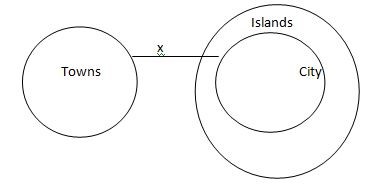Question
Statements:No town is a city. All cities are
islands. Conclusions:I. No island is a town. II. All islands are cities. In each of the questions below are given two statements followed by two conclusions numbered I and II. You have to take the given statements to be true even if they seem to be at variance with commonly known facts. Read all the conclusions and then decide which of given conclusions logically follows from the given statements disregarding commonly known facts. Give answerSolution
No town is a city (E) + All cities are islands (A) ⇒ Some islands are not towns(O*). Hence conclusion I does not follow. All cities are islands(A)⇒ Conversion⇒ Some islands are cities(I). Hence conclusion II does not follow. Alternate Method: 
As per Forest Report 2019, the correct descending order of districts having largest forest area in Rajasthan is -
The Presidency of the G20 for 2024 was formally handed over at the end of the 18th meeting in New Delhi, to the head of which nation?
_____________ is used by fraudsters to install malware through public ports in customers mobile –:
What historical events are associated with King Ratan Chand of the Chand Dynasty?
I) Brought the capital from Champawat to Almora
II) Star...
Which one of the following is correct in respect of Article 41 (Right to work) under the Constitution of India?
In which year was Mahatma Gandhi to spend his time in Champaran, seeking to obtain for the peasant security of tenure as well as the freedom to cultivat...
Rezwana Choudhury Bannya, a Padma Award recipient from Bangladesh, was recognized for her contribution to which field?
What was the percentage of India's urban population in 2011?
Who is known as the 'Missile Man of India'?
A cube of volume 324 cm³ is molded into a cuboid whose length, width, and height are in the ratio 3: 2: 2. Find the length of the cuboid.
Relevant for Exams:


